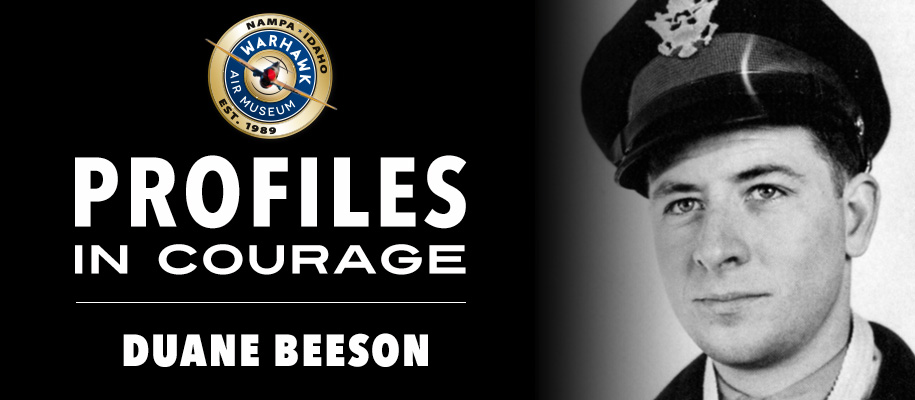
Posted On: February 28, 2023
Duane Willard Beeson was born on July 21, 1921 at St. Luke’s Hospital in Boise, Idaho. He was the firstborn child of Carl and Zelda Beeson, and would later be joined by three sisters Elizabeth, Louise, and Esther. All four Beeson children attended Boise schools and graduated from Boise High School.
Duane was a quiet, serious boy who loved good books and music. He played team sports in grade school; football and boxing in high school. He loved debate and hoped to become a lawyer, reading “Blackwell’s Law” from cover to cover while still in high school. After graduating from Boise High School in 1939, Duane faced a future clouded by the Great Depression. With his father ill, there was no money for college, so he hitch-hiked to Oakland, California hoping to find work and put himself through the University of California. But once again his future was clouded and his plans interrupted as war broke out in Europe. Having read a great deal about Hitler and Fascism, Beeson felt there would be no alternative to all-out war.
Flying with the Eagles
Longing to fly but lacking the two years of college required by the U.S. Army Air Corps, Duane journeyed to Canada to join the Royal Canadian Air Force (RCAF) in 1941. After training, he was sent to England where he distinguished himself as a highly skilled pilot — once landing a Hurricane with a defective throttle locked open by systematically shutting down switches.
Duane was assigned to the No. 71 Eagle Squadron, one of three fighter squadrons (Nos. 71, 121 and 133) of American volunteers in the RCAF formed between September 1940 and July 1941. Inspired by the famed Lafayette Escadrille in World War I, American mercenary Colonel Charles Sweeney had begun recruiting Americans to fight in Europe in 1939. Initial recruits joined at the expense of their American citizenship as America was determined to remain neutral and the 1930’s neutrality acts made it a criminal offense to join the armed forces of a country in war (a blanket pardon was awarded in 1944). These recruits and the handful of Americans already serving in the RCAF formed the first Eagle Squadron (No. 71) during the tail-end of the Battle of Britain (July–October 1940). The Eagles eventually transferred to the U.S. Army Air Force in September 1942, after the U.S. entered the war in December 1941.
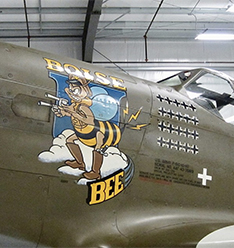
painted in the markings of Boise, ID
native Duane Beeson
Duane flew Hurricanes, Spitfires, P-47 Thunderbolts, and P-51 Mustangs in combat over Belgium, France, Germany, and Britain. Credited with 22 victories, Beeson was one of ten USAAF pilots to become an ace in two different types of fighter aircrafts: the P-47 Thunderbolt and the P-51 Mustang. He excelled at gunnery and insisted on learning the strengths and weaknesses of each aircraft that he piloted with an unrelenting thoroughness. Duane became one of the first flying aces in the unwieldy Thunderbolt and his combat films regularly featured terrifying close-ups of burning splinters and exploding enemy aircraft.
His tactical methods were imitated by many, but his gunnery remained unsurpassed. He was in a neck-and-neck horse race for the honor of being top ace in the European Theater with his friend and fellow Eagle, Don Gentiles. Although extraordinary split-second timing and decision-making were evident in his flying, he was never known as a “hot shot” pilot. His success was based on meticulous preparation and dedication to the task. One letter from a comrade tells how Duane rigged up an outfit with an electric device which indicated hits by flashing a light, in which he spent many hours at practice. Another officer tells how Duane built an attachment with which he was able to use his feet to assist him in aiming.
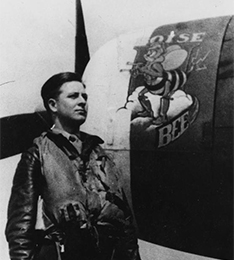
in Britain contributor AAM is licensed
under CC BY-NC 3.0
Beeson with his P-47 Thunderbolt
nicknamed “Boise Bee”.
His ground crew remembered him for his thoroughness and for his unending gratitude for their efforts. They found him intense and serious, but with a quick wit and a ready grin. A low profile individual by nature, Beeson was an unassuming gentleman who firmly believed in the morality of defeating Fascism.
On February 3, 1944 Beeson was awarded yet another Oakleaf cluster for his Distinguished Flying Cross. With his tenth victory he became a double ace and a Captain at the age of 22. In the spring of 1944, during a low level raid over Germany, Beeson’s plane was struck by flak. With a quiet “damn it” he bailed and landed on a fence near a rather attractive woman on a bicycle…who was unfortunately accompanied by some not so attractive German military police. His leg was injured in the fall and Duane was hauled off to a P.O.W. camp where he remained until V.E. Day (May 8, 1945). He was reported to have spent considerable time in solitary for referring to his captors in less than respectful terms. A few months after his release and his 24th birthday, he was promoted to Lieutenant Colonel in October 1945. Duane was always embarrassed about the Purple Heart he earned after his bailout and capture. After three and a half years of blistering combat, the only German object to do him bodily harm was a fence post.
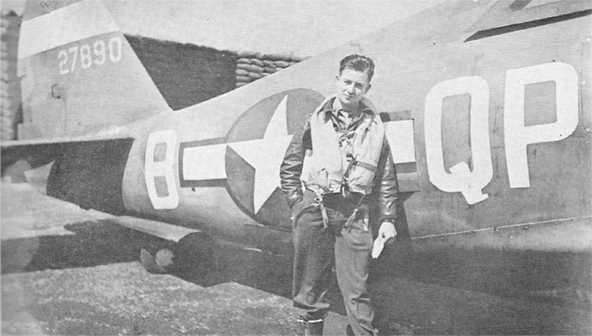
An untimely ending
After the war, Lt. Col. Beeson elected to remain in the military. In February 1947, finally facing a clear and exciting life with a new bride and flying jets, he became violently ill and was diagnosed with a brain tumor. Accompanied by his wife, he was flown to Washington, D.C, but died before the operation could be performed at Walter Reed Hospital. He was buried in Arlington National Cemetery with other military heroes at 25 years old.
The citation to his Distinguished Service Cross gives insight into Duane’s character: “For extraordinary heroism in action with the enemy, 29 January 1944. Captain Beeson, while leading a flight of P-47 aircraft escorting bombers attacking Frankfurt, Germany, led his flight and his squadron down to engage enemy fighters harassing a formation of heavy bombers. As his squadron dived to the attack, Captain Beeson observed six enemy aircraft coming down on his squadron from above. Aware of the immediate danger to his squadron, accompanied only by his wingman, he turned into the incoming aircraft. During the turn, an enemy fighter scored strikes on his tail-plane, impairing the operation efficiency of the aircraft. Despite this, and an unfavorable tactical position, he pressed home his attack against odds of three to one. The daring and vigor of his action scattered the opposing aircraft and permitted his squadron to proceed to the aid of the bombers. In combat ranging from 15,000 feet to 200 feet, Captain Beeson succeeded in destroying two of the enemy, and his heroism no doubt saved many fighters and bombers from damage and possible destruction. The unselfish bravery of Captain Beeson reflects great credit upon himself and the Armed Forces of the United States.”
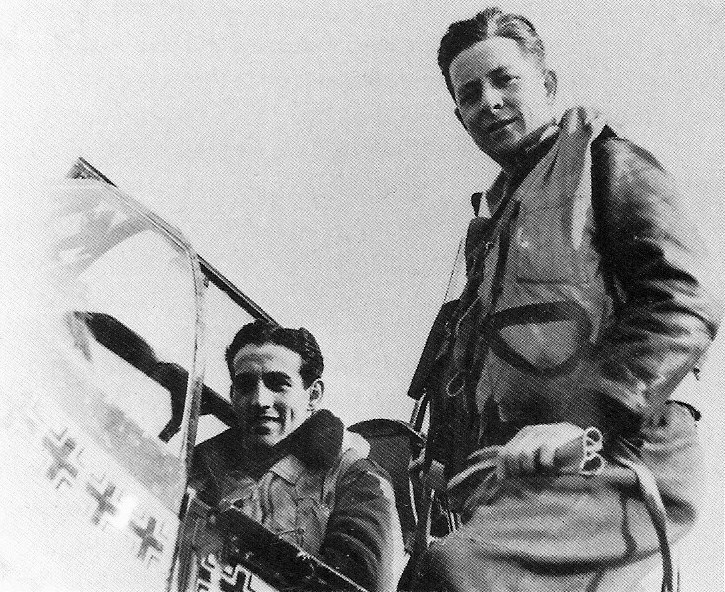
Captain Don Gentile (seated) and Capt. Duane Beeson in April 1944.
Beeson’s military decorations
- The Silver Star
- The Distinguished Flying Cross with Six
- The Distinguished Service Medal
- The Distinguished Unit Medal
- The Air Medal with Five Oak Leaf Clusters
- The Purple Heart
- The American Defense Medal
- The European Campaign Medal
- The Victory Medal
- The Prisoner of War Medal
- The British Distinguished Volunteer Medal
- The Battle of Britain Star
- The British War Medal
- The British Defense Medal
- The Belgian Croix de Guerre with Palms
- Oak Leaf Clusters
Resources:
- https://acesofww2.com/USA/aces/beeson/
- http://www.4thfightergroupassociation.org/uploads/8/2/0/3/8203817/334_beesondwweb_a.pdf
- https://www.rafmuseum.org.uk/research/online-exhibitions/americans-in-the-royal-air-force/eagle-squadrons/
- https://warfarehistorynetwork.com/americans-in-the-royal-air-force/
- https://www.americanairmuseum.com/archive/person/duane-willard-beeson
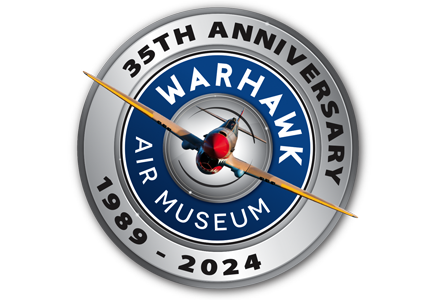



The depth of our gratitude for his noble character and immeasurable performance can only be equalled by our sorrow at his early demise.